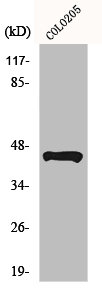TUSC3 Antibody
-
货号:CSB-PA003359
-
规格:¥880
-
图片:
-
其他:
产品详情
-
Uniprot No.:Q13454
-
基因名:
-
别名:TUSC3; N33; Tumor suppressor candidate 3; Dolichyl-diphosphooligosaccharide--protein glycosyltransferase subunit TUSC3; Oligosaccharyl transferase subunit TUSC3; Magnesium uptake/transporter TUSC3; Protein N33
-
宿主:Rabbit
-
反应种属:Human,Mouse,Rat
-
免疫原:Synthesized peptide derived from the Internal region of Human N33.
-
免疫原种属:Homo sapiens (Human)
-
标记方式:Non-conjugated
-
抗体亚型:IgG
-
纯化方式:The antibody was affinity-purified from rabbit antiserum by affinity-chromatography using epitope-specific immunogen.
-
浓度:It differs from different batches. Please contact us to confirm it.
-
保存缓冲液:Liquid in PBS containing 50% glycerol, 0.5% BSA and 0.02% sodium azide.
-
产品提供形式:Liquid
-
应用范围:WB, IHC, IF, ELISA
-
推荐稀释比:
Application Recommended Dilution WB 1:500-1:2000 IHC 1:100-1:300 IF 1:200-1:1000 ELISA 1:10000 -
Protocols:
-
储存条件:Upon receipt, store at -20°C or -80°C. Avoid repeated freeze.
-
货期:Basically, we can dispatch the products out in 1-3 working days after receiving your orders. Delivery time maybe differs from different purchasing way or location, please kindly consult your local distributors for specific delivery time.
相关产品
靶点详情
-
功能:Acts as accessory component of the N-oligosaccharyl transferase (OST) complex which catalyzes the transfer of a high mannose oligosaccharide from a lipid-linked oligosaccharide donor to an asparagine residue within an Asn-X-Ser/Thr consensus motif in nascent polypeptide chains. Involved in N-glycosylation of STT3B-dependent substrates. Specifically required for the glycosylation of a subset of acceptor sites that are near cysteine residues; in this function seems to act redundantly with MAGT1. In its oxidized form proposed to form transient mixed disulfides with a glycoprotein substrate to facilitate access of STT3B to the unmodified acceptor site. Has also oxidoreductase-independent functions in the STT3B-containing OST complex possibly involving substrate recognition.; Magnesium transporter.
-
基因功能参考文献:
- miR-UL112-3p exerts its oncogene function by directly targeting TUSC3 in Glioblastoma. PMID: 28303930
- study demonstrated an oncogenic role of TUSC3 in Non-small cell lung cancer and showed that dis-regulation of TUSC3 may affect tumour cell invasion and migration through possible involvement in the Hedgehog (Hh) signalling pathway. PMID: 28487226
- TUSC3 may act as an oncogene in the progression of colorectal cancer. PMID: 30115537
- TUSC3 can function both as an oncogene and as a tumor suppressor. (Review) PMID: 28929175
- our data indicate that miR-132 induces temozolomide resistance and promotes the formation of cancer stem cell phenotypes by targeting TUSC3 in glioblastoma. PMID: 28901390
- This paper supports the previous clinical descriptions of the condition caused by TUSC3 mutations and describes the seventh family with mutations in this gene, thus contributing to the genetic spectrum of mutations. This is the first report of a family from the Arabian peninsula with this form of Intellectual disability . PMID: 27148795
- SOX2 regulates the proliferation, migration and invasiveness of breast cancer cells through miR-181a-5p and miR-30e-5p which modulate TUSC3 protein levels PMID: 28288641
- Decreased Tumor Suppressor Candidate 3 Predicts Poor Prognosis of Patients with Esophageal Squamous Cell Carcinoma PMID: 27994502
- TUSC3 regulates proliferation and invasion of glioblastoma cells by inhibiting the activity of the Akt signaling pathway. PMID: 27177902
- decreased immunological TUSC3 staining is a factor prognostic of poor survival in pancreatic cancer patients. PMID: 26871953
- The TUSC3 gene is associated with mental retardation in the Qinba mountain area in China; the sixth exon of the TUSC3 gene may contribute to the risk of developing the disease. PMID: 25966277
- Report frequencies of short tandem repeat markers linked to TUSC3 (MRT7) or NSUN2 (MRT5) genes used for homozygosity mapping of recessive intellectual disability. PMID: 26427135
- TUSC3 loss alters the ER stress response and accelerates prostate cancer growth in vivo PMID: 24435307
- Loss of TUSC3 alters the molecular response to endoplasmic reticulum stress. PMID: 25735931
- IGFII and N33 methylation status may be related to gastric carcinogenesis. PMID: 25086101
- TUSC3 increases glycosylation efficiency for a subset of human glycoproteins by slowing glycoprotein folding. PMID: 24685145
- Homozygous deletion in TUSC3 causes syndromic intellectual disability. PMID: 23825019
- TUSC3 is a tumor suppressor gene in ovarian cancer. PMID: 23404293
- Genotyping and linkage analysis excluded linkage of the GRIK2 gene and TUSC3 gene with mental retardation. PMID: 21557188
- A novel nonsense mutation in TUSC3 is responsible for non-syndromic autosomal recessive mental retardation PMID: 21739581
- analysis of a novel deletion mutation in the TUSC3 gene in a consanguineous Pakistani family that may have a role in autosomal recessive nonsyndromic intellectual PMID: 21513506
- These findings suggest that inactivation through methylation of the putative tumor suppressor genes N-33 may not be associated with colorectal carcinogenesis in UC. PMID: 20505342
- Down regulated in ovarian cancer or absent in ovarian cancer and impact survival. PMID: 16270321
- N33, STK11 (19p13) and TP53 might play a role in the development of metastasis in larynx and pharynx squamous cell carcinomas. PMID: 17641416
- TUSC3 is only the fifth gene implicated in NS-ARMR and the first for which mutations have been reported in more than one family. PMID: 18452889
- study shows that mutations in two OTase-subunit genes, N33/TUSC3 and IAP result in autosomal-recessive nonsyndromic mental retardation PMID: 18455129
- Knockdown of either MagT1 or TUSC3 protein significantly lowers the total and free intracellular Mg(2+) concentrations in cell lines. PMID: 19717468
显示更多
收起更多
-
相关疾病:Mental retardation, autosomal recessive 7 (MRT7)
-
亚细胞定位:Endoplasmic reticulum membrane; Multi-pass membrane protein.
-
蛋白家族:OST3/OST6 family
-
组织特异性:Expressed in most non-lymphoid cells and tissues examined, including prostate, lung, liver, colon, heart, kidney and pancreas.
-
数据库链接:
HGNC: 30242
OMIM: 601385
KEGG: hsa:7991
STRING: 9606.ENSP00000221167
UniGene: Hs.426324
Most popular with customers
-
-
YWHAB Recombinant Monoclonal Antibody
Applications: ELISA, WB, IF, FC
Species Reactivity: Human, Mouse, Rat
-
Phospho-YAP1 (S127) Recombinant Monoclonal Antibody
Applications: ELISA, WB, IHC
Species Reactivity: Human
-
-
-
-
-






















